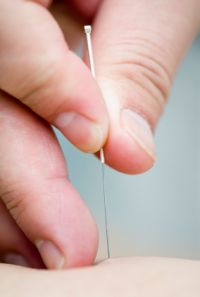Dry Needling

Dry Needling, also known as intramuscular stimulation (IMS) and trigger point dry needling (TDN), is a safe, effective and efficient treatment used to:
- Relax myofascial trigger points, and
- Restore normal muscle tones, muscle length, coordination, function and strength
Dry needling is called such because the needles used in this treatment method are “dry”, solid filament needles, versus hypodermic needles that can inject medication or draw fluids through them. It was first introduced by Czech physician Karel Lewit in 1979, when he noticed that that inserting solid filament needles into myofascial trigger points (MTrP) can cause favorable biochemical changes that assist in reducing pain.
Dry needling involves insertion and repetitive manipulation of the needle in the trigger point in order to produce an involuntary spinal cord reflex, also known as a local twitch response (LTR). This results in lasting muscle relaxation due to the release of shortened bands of muscle fibers for overactive (tight) muscles or the activation of under-active (weak) muscles. Deactivation of the trigger points can bring immediate relief of symptoms, so the therapist can immediately train the muscles to work with the newly gained pain free range of motion.
Dry Needling Versus Acupuncture
Dry needling is similar to acupuncture in the sense that a dry, solid filament needle is inserted and manipulated under the skin to release endorphins and serum cortisol for pain relief. But, this is where the similarity ends.
Dry needling is best on western neuroanatomy and modern scientific study of the musculoskeletal and nervous systems. It is used for the assessment and treatment of myofascial pain syndromes and dysfunction due to myofascial trigger points / tension areas / muscle spasm / increased tonicity (the direct and palpable source of patient pain). It targets the myofascia (connective tissue covering the muscles) lying just below the skin, including trigger points, and achieves pain relief by inactivating these trigger points at the muscle cell level. This relaxes the muscles due to the release of shortened bands of muscle fibers and stimulation of collagen and protein formation. Deep dry needling (DDN) involves needling deeper muscles and the thin tissue covering bone (periosteum).
Acupuncture is based on traditional Chinese medicine (TCM). It creates balance in the body by influencing the flow of Qi (energy) in pathways called meridians to achieve pain relief and alleviate inflammation.
Conditions Treated by Dry Needling
Dry needling is used to treat a variety of conditions including:
- Head and Neck Pain – including whiplash and headaches / migraines, degenerative joint disease, degenerative disk disease or osteoarthritis
- Otological (Ear) and Opthamological (Eye) Pain – including tinnitus and eye strain
- Dental (Teeth) and Orthodontic (Jaw and Occlusal) Pain – including cavities, temporomandibular joint (TMJ) dysfunction, tooth impaction and root problems
- Shoulder Pain – including rotator cuff muscle tears, bursitis, adhesive capsulitis (frozen shoulder), tendonitis and impingement syndrome
- Elbow Pain – including lateral epicondylitis (tennis elbow) and medial epicondylitis (golfer’s elbow)
- Hand and Wrist Pain – including gamekeeper’s thumb, DeQuervain’s syndrome, carpal tunnel syndrome, degenerative joint disease and osteoarthritis
- Back and Hip Pain – including lumbar degenerative disc disease, arthritic changes and herniated discs
- Knee Pain – including degenerative joint disease or osteoarthritis
- Shin / Ankle / Foot Pain – including shin splints, gout, metatarsalgia and Morton’s neuroma
- Plantar Fasciitis (Heel Pain)
- Acute and Chronic Tendonitis
- Athletic and Sports-related Overuse Injuries
- Post-surgical Pain
- Post-traumatic Injuries, Motor Vehicle Accidents (MVA), and Work-related Injuries
- Other Chronic Pain Conditions
People with overuse injuries, work injuries, auto accident injuries, sports injuries or other chronic pain conditions who have good results with massage but are disappointed when the discomfort returns may find dry needling a great way to get more long lasting pain relief.
